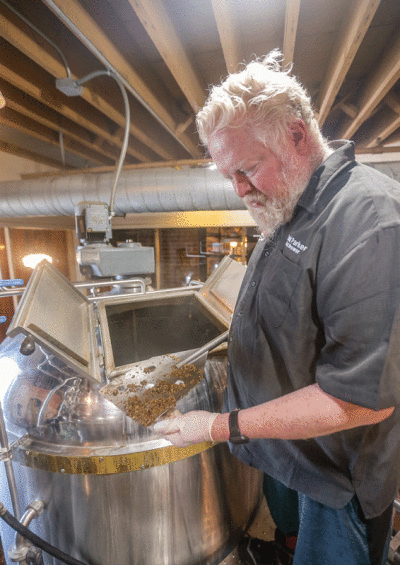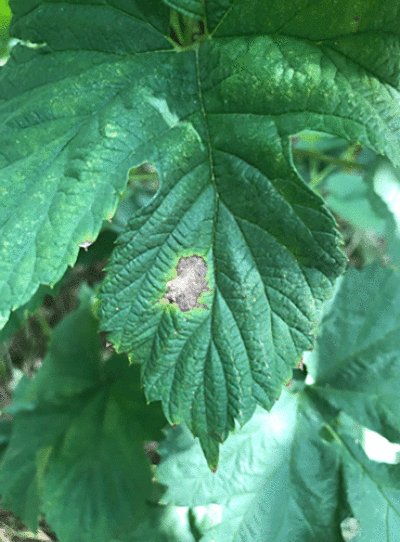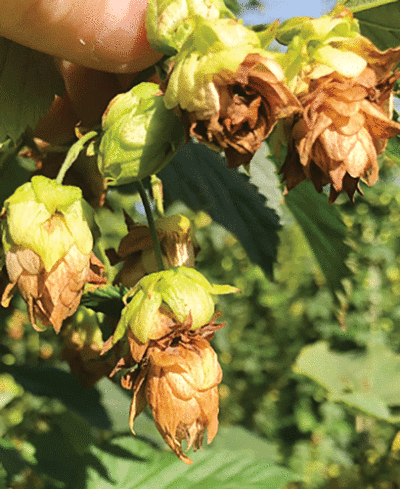
Brewmaster Todd Parker uses a tool to show off the hops while brewing at Rochester Mills Beer Co.
Photo by Patricia O’Blenes

A black spot from halo blight can be seen on a leaf.
Photo provided by Michigan State University College of Agriculture and Natural Resources

alo blight can be seen on hops cones. The recently discovered fungal disease kills hops crops, leaving a “halo” of green at the top of the cone while the rest dies.
Photo provided by Michigan State University College of Agriculture and Natural Resources
METRO DETROIT — Michigan farms may be known for crops like cherries and corn, but in recent years, a new homegrown crop has taken the state by storm — the humble, hearty hop.
Originally brought to Michigan over 100 years ago during a homesteading boom, the past 20 years have seen a rise in Michigan hops production. And while Michiganders have been able to reap the rewards of this rise, thanks to breweries macro and micro, things have not gone down entirely smoothly at the hops farms.
Michigan hops are uniquely vulnerable to diseases, a problem caused by the high-moisture environment anyone from the Great Lakes State is well aware of.
“A lot of our cultivars that are currently available at commercial levels were bred and developed for growers in other parts of the world where they don’t receive as much rain,” said Erin Lizotte, Integrated Pest Management coordinator and senior statewide educator with the Michigan State University Extension. “We’re kind of fighting an uphill battle because we have much wetter weather here in Michigan, so we need our breeding program to develop cultivars that are more at home in those wetter environments and more disease resistant to those diseases we see in wetter environments.”
This moisture vulnerability has opened the door for a variety of infections to take hold of the state’s hops crops, the two most pressing being downy mildew and halo blight.
“Downy mildew has been around since the beginning,” Lizotte said. “I’d say that’s the disease we have spent the most resources and time on tackling, and I think we’ve gotten to a point where growers are able to manage downy mildew effectively on-farm.”
Downy mildew shows up as a fuzzy spore mass on leaves, turning the undersides black. It has proven very resistant to winter conditions, so early-season pruning has proven to be the most effective way of preventing its spread. MSU research has also allowed farmers to begin using plants more resistant to downy mildew infections.
While downy mildew is an old problem for hops growers, halo blight is the new troublesome fungus on the scene. MSU researcher Timothy Miles was the first to take notice of the disease in 2018. It shows up as black splotches on leaves and kills hops flowers in a way that leaves only parts close to the stem untouched — a green halo atop a pale infected cone.
“Since (2018), his lab and crew have been sussing out what (halo blight’s) life cycle looks like, as well as how we can potentially control it in hopyards,” Lizotte said.
While the search for the secret to stopping halo blight is ongoing, MSU researchers have made strides in combating hops-affecting viruses. Carolyn Malmstrom’s work in the field led to her developing hops virus testing protocols, allowing growers to send samples to MSU for testing and diagnosis.
As it stands, the surefire way of fighting disease on hops is by preventing it from taking hold. Farms, nurseries and other growers can keep plants and seeds sanitized, infected leaves and flowers can be pruned away and disposed of, and fungicides can be applied to plants to kill whatever lingering disease remains. But Lizotte said the goal of MSU’s scientists is to have plants become naturally immune to common diseases.
“I don’t want to call it a Band-Aid, what we’re doing now in terms of fungicides and cultural management practices, but we’re also really hopeful that, down the road, we can start to transition to cultivars that are just more at home and happy growing in Michigan,” Lizotte said.
Until then, frequent vegetation management and other prevention methods are the best way of ensuring large, quality crop yields.
Todd Parker, the head brewer at Rochester Mills Beer Co., said they go through Michigan hops providers when they can and that the state of Michigan has a good hop industry.
“Definitely knowing your supplier is important,” Parker said. “A lot of the suppliers are good about keeping the diseased hops out of the system.”
Jeremey Lewis, the brewer and co-owner of the Copper Hop Brewing Co. in St. Clair Shores, and co-owner Ryan Balicki said in emails that they couldn’t speak about the overall health of hops in the state. But Lewis said they use 45th Parallel as the distributor for their in-state hops — this includes Cascade, Centennial, Mittelfruh and Fuggle varieties — and that they’ve never had a problem.
“I typically order what I need for the coming year in October after the harvest,” Lewis said in an email. “I have never had an issue with being able to get what I need. The quality has been outstanding and year to year very consistent.”
Brian Tennis, owner and founder of Hop Alliance, said it was too early to tell how the crops for this year will do, but that last year was one of their best harvests yet because of good weather and other factors.
He said their hops weren’t affected by diseases last year.
“Fortunately, not for us,” Tennis said. “We’re up right up in the Leelanau (Peninsula), like right around the 45th Parallel, so we really haven’t seen a lot of the damages that some of the other farmers in the state have.”
Lizotte says MSU researchers have been involved in studying hops since “day one” of the plant’s return to the Mitten State in the 2000s, planting the seeds for what has become a strong partnership between the growing industry and academia.
“The partnership between the university and the industry is really critical to both of us,” Lizotte said. “We really take our lead from the industry on what their priority needs are. Without the industry of research at MSU, I don’t think we would have a hops industry in Michigan.”
 Publication select ▼
Publication select ▼























